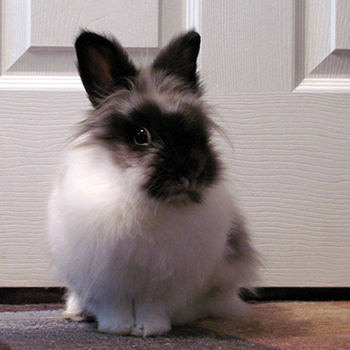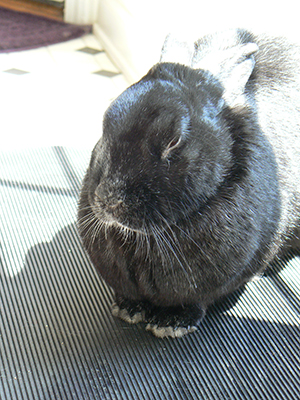 I met my first house rabbit back in 1980. A coworker of my father had two pet bunnies who had one litter of four bunnies and a month later another litter of eight. The woman brought the first litter in to where my father worked when the bunnies were six weeks old and offered them to anyone who would give them a good home. My father picked out the spunkiest one in the bunch and brought him home. We were very unoriginal and called him Thumper. That was the only bunny rabbit name we knew of besides Bugs Bunny and he didn’t look like a Bugs Bunny, so Thumper it was.
I met my first house rabbit back in 1980. A coworker of my father had two pet bunnies who had one litter of four bunnies and a month later another litter of eight. The woman brought the first litter in to where my father worked when the bunnies were six weeks old and offered them to anyone who would give them a good home. My father picked out the spunkiest one in the bunch and brought him home. We were very unoriginal and called him Thumper. That was the only bunny rabbit name we knew of besides Bugs Bunny and he didn’t look like a Bugs Bunny, so Thumper it was.
My family was clueless about taking care of a bunny rabbit, but we had some experience with hamsters and guinea pigs and started out at that point. Mom got Thumper a cage, water bottle, food crock and some small animal pellets. We had him in the kitchen which was the most interior room of the house, but even so, he caught cold during the first two weeks in the bitter northern Ohio weather (post on keeping rabbits warm). That is when we got lucky and found a small animal practice in our area who treated cats, dogs, guinea pigs, birds, and rabbits. They helped us to learn about feeding, clipping nails, rabbit health, and so much more over the ten years of Thumper’s life.
I was still living at home but had just started my first full-time job. It was a night job and I would stay up on my nights off. My first night off after Thumper caught cold, I listened to him sneezing like crazy. I got him out of his cage, wrapped him in a towel and sat down in a huge upholstered rocker we had. He snuggled his head under my chin, stopped sneezing and went to sleep. That began his reign as a snuggle bunny. Thumper liked being picked up and held and would paw at my ankles or moms when he wanted some cuddling. He would always squirm up until he had his head tucked in to my neck right under my chin. Then he would zone out while I petted him.
At the time Thumper arrived in our lives, there was no House Rabbit Society or internet to turn to for advice on rabbit care. Anything written was by breeders and geared towards raising rabbits as farm or show rabbits. Besides our vet, Thumper himself proved himself a good teacher on rabbit care and behavior. He picked out one place in the kitchen as a bathroom and mom wondered if we could put a litter box there and train him. As soon as she put the litter box in place, Thumper was trained. We checked out things geared for cats and bought a kitty harness and leash. As soon as Thumper realized the connection between being put in his harness and going outside, he would hold perfectly still so that we could get the harness just right. We would take him on short walks in the front and back yard and it was always funny to watch people do a double take when they realized we were walking a rabbit.
Thumper had some life long tummy issues. We realize with the information out now, they were probably due to his leaving his mother a few weeks too early. He was our first experience with a poopy bunny butt. With the vet’s assistance we learned about what to do with diet and medication when that would happen. We learned to mummy wrap him and syringe medicate him. We figured out a means on our own of giving him just a partial bath (more on poopy bunny butt baths) to get him cleaned up again. We had to medicate him many times over the years for his tummy problems and he learned a few tricks too. We would use a syringe for the medicine, but he learned how to not swallow and let it just drool back out of his mouth. When we would mummy him in a towel, he learned how to play turtle and get his face below the lip of the towel no matter how close we tried to get it under his head. The term rabbittude didn’t come to mind until later after other bunnies came in to my life, but Thumper was showing his rabbittude even though I didn’t recognize it as such at the time.
Thumper was my first learning experience of how personable, playful and intelligent a rabbit can be. Mom had a coconut sitting on a newspaper on the kitchen floor waiting to break it open. When Thumper saw it, he pounced on it, batted it into submission with his front paws, and then claimed it as his by chinning it to death. After that we tried more toys for him to play with. Our other pet at the time was a large retriever mix dog that we were careful to let out in the yard when Thumper was running free in the house. Someone let the dog in by accident during Thumper’s run time and the retriever started to chase him. We were terrified and so scared for Thumper, because both he and the dog were moving too fast for us to get to them quickly enough. Thumper was running at top speed when suddenly he doubled back straight through the dog’s legs. The dog was immediately thrown off-balance and while the dog was trying not to fall, Thumper hopped back in his cage and we closed the door protecting him again. We made certain they were never accidentally loose together again after that.
Thumper had his own personal rock star rabbit routine that he developed when he didn’t feel pampered enough that is a whole story all on its own. More about that next Thursday …


 Leo dictated a change in topic from what was planned for today. I got his dinner greens ready for him and he had absolutely no interest in them. Now having no interest in eating for a rabbit can be due to not feeling well or having a digestive problem going on. It could be they have been given something they don’t like to eat. It could be they have already eaten too much of something else and aren’t hungry.
Leo dictated a change in topic from what was planned for today. I got his dinner greens ready for him and he had absolutely no interest in them. Now having no interest in eating for a rabbit can be due to not feeling well or having a digestive problem going on. It could be they have been given something they don’t like to eat. It could be they have already eaten too much of something else and aren’t hungry.

 Now you might be reading this and thinking this sounds really messy and perhaps you have some skin issues of your own that using a bare hand would not be a good choice. Have no fear, lightweight gloves are readily available now. We pick up boxes of powder free nitrile gloves from our local home improvement store that we use for many household tasks. We use the nitrile powder free gloves because powder is a lung and skin irritant for us, so we avoid any gloves that aren’t powder free. We are avoiding latex gloves, because they can cause allergies in humans. I wear a glove on just the hand that needs to be in the water doing the poopy butt clean up. Due to eczema, my hands are sometimes prone to issues of it flaring up if my skin comes in contact with water too often. Our choices in how we care for the bunnies are based on our own experience of blending the needs of both bunny and human. I am sharing about the gloves for anyone else like myself where a poopy butt bath could present a challenge to best maintaining your own sensitive skin without harm.
Now you might be reading this and thinking this sounds really messy and perhaps you have some skin issues of your own that using a bare hand would not be a good choice. Have no fear, lightweight gloves are readily available now. We pick up boxes of powder free nitrile gloves from our local home improvement store that we use for many household tasks. We use the nitrile powder free gloves because powder is a lung and skin irritant for us, so we avoid any gloves that aren’t powder free. We are avoiding latex gloves, because they can cause allergies in humans. I wear a glove on just the hand that needs to be in the water doing the poopy butt clean up. Due to eczema, my hands are sometimes prone to issues of it flaring up if my skin comes in contact with water too often. Our choices in how we care for the bunnies are based on our own experience of blending the needs of both bunny and human. I am sharing about the gloves for anyone else like myself where a poopy butt bath could present a challenge to best maintaining your own sensitive skin without harm.

 The last year and a half of Shadow’s life, he had trouble with allergies. During the spring and fall seasons when humans would be sniffling, sneezing and having a post nasal drip, Shadow would be sneezing too. We could tell he was also experiencing a post nasal drip, because like many humans, he would put his nose up higher in the air, stretching out his neck and then we would see him swallowing.
The last year and a half of Shadow’s life, he had trouble with allergies. During the spring and fall seasons when humans would be sniffling, sneezing and having a post nasal drip, Shadow would be sneezing too. We could tell he was also experiencing a post nasal drip, because like many humans, he would put his nose up higher in the air, stretching out his neck and then we would see him swallowing.

